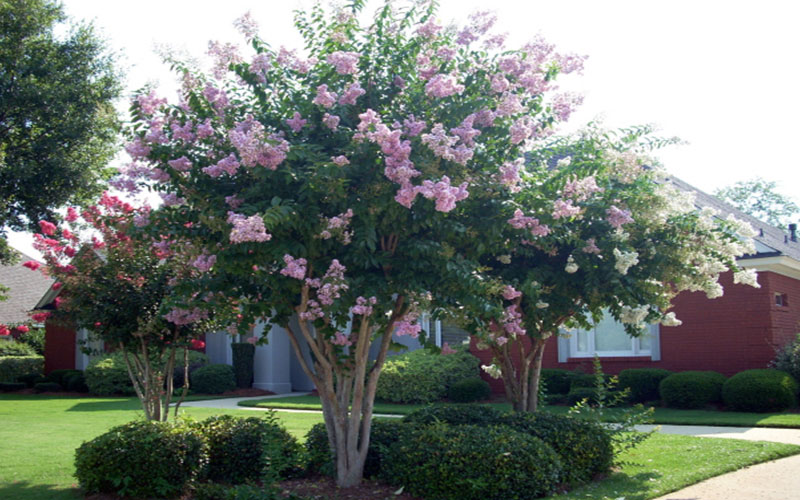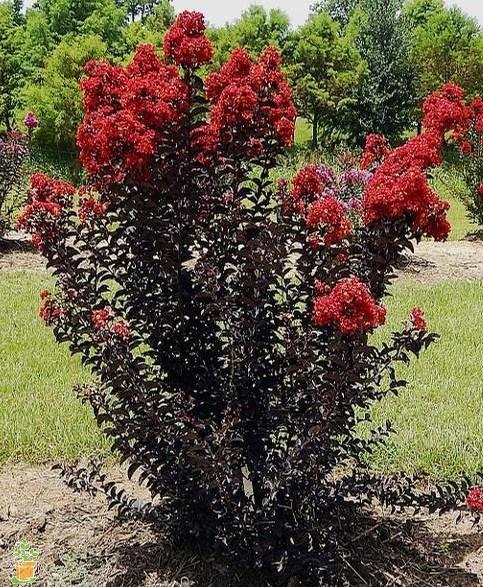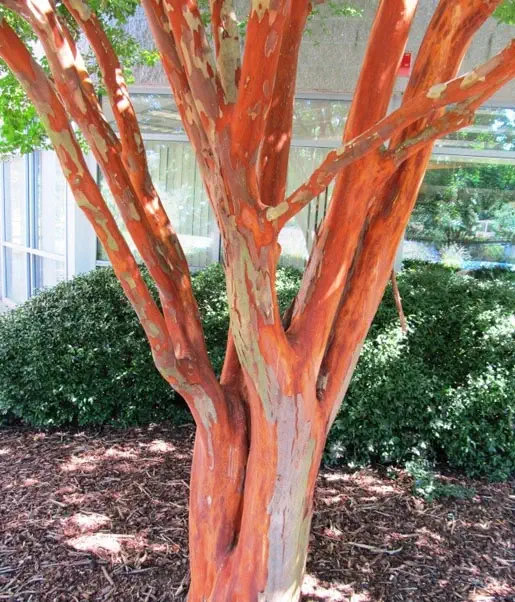THE CREPE MYRTLE
Summer is almost here and that means that crepe myrtles are almost in full bloom! Crepe myrtles are ubiquitous in yards across the south and are known for their vibrant color and ability to ensure hot, humid weather. They are often referred to as the “lilac of the south.”

Crepe myrtles, known as the “lilac of the south” come in a variety of colors, shapes, and sizes.
THE CREPE MYRTLE ATTRIBUTES
Crepe myrtles can be grown as either a shrub or small tree and are often used in groupings to create privacy hedges. Their average height is between 15 and 25 feet and they can grow fast – up to 2 feet in 1 year! They bloom in early to midsummer and colors include ranges of white, lavender, purple, pink, magenta, and red. Dark green foliage turns red-orange in the fall and falls off in the winter exposing beautiful cinnamon bark. A relatively new series, Black Diamonds, provides unique black foliage that lasts until the first frost, though they do tend to be smaller in both height and weight than traditional crepe myrtles. Crepe myrtles are low-maintenance and once established, are easily able to survive periods of drought.
CREPE MYRTLE BARK SHEDDING
Some people may think that bark shedding is a sign of disease and may attempt to treat it. However, bark peeling or shedding is normal on crepe myrtles and occurs after the tree has reached full maturity. If you notice peeling on a crepe myrtle, leave it alone. The resulting coloration is stunning and will reveal a range of colors, from cream, warm beige, cinnamon, and bright red.

The Black Diamond, a new series of crepe myrtles, produces black foliage that lasts until the first frost.

Bark peeling is normal on crepe myrtles and reveals an array of colors.
PLANTING
When planting a new crepe myrtle, you should dig a hole approximately twice the size of the root ball. It should be planted in a location where it will receive full sun, at least six hours per day and at the same depth that it was in the nursery pot. A few inches of mulch can be applied around the base of the crepe myrtle and watering should be done regularly for at least several months. Though they can grow in a wide range of soil, it is important to ensure adequate drainage to prevent root rot.
INSECTS AND DISEASES THAT AFFECT THE CREPE MYRTLE
Like all shrubs and trees, the crepe myrtles are susceptible to certain insects and diseases. The most common issue with crepe myrtles is powdery mildew caused by hot, humid days followed by cool, dewy nights. Crepe myrtles are also known to suffer from leaf spot, dark brown spots on the leaves that causes them to turn yellow and fall off. Both powdery mildew and leaf spot can be treated with a fungicide. Sooty mold, caused by aphid excretions, are also known to be problematic and can be treated with an insecticide.
CREPE MYRTLE PRUNING
Contact TREES BY JAKE, your Tulsa tree service with extensive experience in pruning decorative and ornamental shrubs and trees. As a Certified Arborist, Jake is fully knowledgeable in the proper way to prune a crepe myrtle without affecting blooming. Other tree services include tree trimming, tree cutting, and stump grinding, to name a few. Contact us today at 918-500-9955 and check us out on social media on Facebook, Instagram, Twitter!
FREQUENTLY ASKED QUESTIONS
How fast do crepe myrtles grow?
Crepe myrtles grow at a pace of around 24 inches each year, and when fully mature, they can reach a maximum of 15 to 25 feet and spans between 6 to 15 feet.
When do crepe myrtles bloom in Oklahoma?
Crepe myrtles bloom mostly between the middle of May and early June. Depending on its variety, flowering might last anywhere from 90 to 120 days.
How much do crepe myrtles cost?
Nurseries have crepe myrtles for sale. Plants in 200 mm (8 inch) pots cost approximately $20, while bigger plants in 300 mm (12 inch) pots cost around $65.
When is the best time to plant crepe myrtles?
June through late September is the ideal time to grow crepe myrtles because of the warm soil. Watering during summer or dry periods is helpful to the trees' flowering. When the tree is already established on the land, crepe myrtle's can survive drought.
How to plant a crepe myrtle?
1. Begin by making a large planting hole that is at least three times the width and depth of the root ball of your crepe myrtle. Remove native soil from the planting hole and place it around its edge.
2. To get the crepe myrtle from its container, grab the base or the trunk and carefully lift the plant. If the mass of roots is stuck, you can cut it or try to turn the plant on the side, and pat the container from the outside to loosen the rootball. Using your hand or a tool, remove the small, thin roots from the plant also known as feeder roots. Wash away remaining dirt and further loosen the rootball with water.
3. Set the crepe myrtle in the planting hole, so that the top edge of the rootball is at or slightly above ground level if you're planting in a well-drained soil. Add more mixture of backfill soil to the planting hole to obtain the appropriate planting height if needed.
4. Straighten the tree with one hand and begin back-filling the soil mixture around the mass of roots, tamping to remove air pockets. Begin dampening the soil after you've filled the hole halfway until you reach the upper border of the root ball. Avoid putting dirt on top to avoid suffocating your plant.
5. Water the planting area well, including the root ball, to a depth equal to the root ball's height. To stimulate early root development and improved root growth, you may also water your newly planted crepe myrtle with a solution.
6. Apply an inch or two of cured and shredded wood mulch or pine straw around the planting area to preserve moisture and prevent weed formation. Nutrients will be supplied to the soil where your crepe myrtle is planted when the mulch decomposes. To avoid rotting the bark, avoid piling right against the plant's root.
Contact Your
Tulsa Tree Service
TREES BY JAKE has been providing tree removal services in Tulsa for over a decade. Jake is a Tulsa Certified Arborist and we have a variety of equipment to safely and efficiently remove trees. Call or text us today for your free estimate at 918-500-9955 and don’t forget to check us out on Facebook, Instagram, and Twitter!